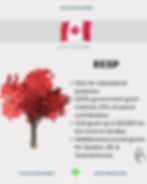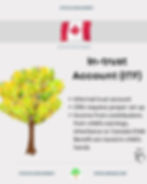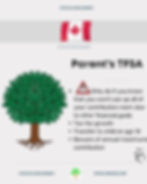Investing for kids? Use these accounts
- mcorbic
- Jan 19, 2022
- 10 min read
One of the frequent questions that I get from parents is “If I invest on behalf of my child, what account should I use?”. I am going to share your options with you, but I want to warn you that this is a heavy post packed with a lot of useful info.
I asked my husband to proofread it before I posted it, and his comment was that I need to make this post lighter. I chose not to. I believe that if you are here, spending your time reading this, it’s because you want quality information in one place rather than searching for it all over the internet.
Before you scroll further, it is important that you understand this. As a CPA, I strongly suggest that you have a discussion with your tax accountant and based on your financial goals to determine the best account for investing on behalf of your child. This may not be what you want to hear, but from experience I can tell you that there is no one-fit-all approach for every family.
You may choose not to have only one account, but a mixture of different accounts. Personally, we have invested in various accounts for my kids as we have a few different goals that we are trying to achieve.

I am going to discuss options for Canadians first, then I will discuss options for Americans. If you want to skip all the way to the American part, click here.
Canadian investment accounts for kids
In Canada we do not have as many options when it comes to investing on behalf of our kids as our American neighbors. Our options are:
Registered Education Savings Plan (RESP)
Custodial in-trust account
Use parent’s TFSA room
In a nutshell, we only really have two options; the RESP and the custodial in-trust account, but I am throwing in the TFSA option, which is not intended for investing on behalf of your child, but can be used if needed.
If you are certain that your child will obtain post-secondary education, the RESP account is a good option. However, if you want to invest on behalf of your child, so that they have enough money to purchase their first home, retire early or accomplish a different goal, you should consider investing in a custodial in-trust account, which is an informal trust account.
It is important to note that even with the custodial in-trust account, you and your child will be subject to taxes on future earnings in the account. The only way to avoid taxes would be if you use a portion of your own TFSA room to invest on behalf of your child and then transfer that money to them when they turn 18. I will discuss each of these strategies in detail below.
RESP account
If you invest into a RESP account on behalf of your child, the money in the account can only be used for education purposes for the child. They will need to enroll in a qualifying educational post-secondary program.
When you invest into RESP for your child, you are not able to deduct your contributions from your income for tax purposes. When your child receives the money from an RESP to help finance the cost of the post-secondary education, your child will have to include this income on their tax return. Hopefully at that time, there will be no adverse tax consequences to your child considering that they are a student and their taxable income is low.

You can contribute the maximum amount of $50,000 per child, which is a lifetime limit. The government wants to encourage parents’ investing in future education of their children, so they offer Canada Education Savings Grant (CESG), which matches 20% of parent contributions to a RESP. For example, if you invest $100, the government will add another $20 to that account. They will contribute up to a maximum of $500 per year and $7,200 in total over the years. Also if you qualify as a low income family, your child will be eligible for another $100.
Additionally if you are a low income family, you may qualify for a Canada Learning Bond (CLB) and receive up to $2,000 from the government towards your child’s education, even if you have not contributed towards your child’s RESP.
If you live in Quebec, Saskatchewan or British Columbia, you should check if you qualify for their provincial initiatives for opening a RESP account for your child.
CESG, CLB and the provincial initiatives are free money, so why not take them if you can? However, you should keep in mind that if your child decides not to go to a post-secondary school, you will be able to keep your monetary contributions, but not the government grants. Alternatively you can keep all the money if you could transfer the RESP to a sibling who is under 21 years of age.
Does it make sense to invest in RESP? It makes sense if you are planning to use all that money for your child’s post-secondary education. However, if you have other plans for that money, you should consider other options that I discuss below.
In Trust Account (ITF)
If you want to invest on behalf of your child for purposes other than education, you may also consider setting up an informal in-trust custodial account. This is an account in your child’s name that is managed by a trustee that you appoint until the child becomes of age. When that happens, usually the trustee will transfer the account directly to the child. This transfer is not taxable as ownership of the account is not changing. The transfer will allow the child to assume authority over the account and make their own investment decisions.

Essentially in-trust accounts are very similar to formal trust accounts. The difference is that the formal trust accounts are created by a legal document (deed of trust) that is drafted by a lawyer. The informal trust accounts can be set up with most financial institutions. They are easy to set up, which also saves money because you can skip paying lawyer fees.
It is important to keep in mind that when it comes to taxation, the Canada Revenue Agency likes to see proper documentation as to who is the official account contributor, beneficiary and trustee. This helps with CRA not taxing the interest, dividends and capital gains in the hands of a contributing parent.
Additionally, when it comes to taxation, contributions made to the in-trust account are not tax deductible by a contributing parent. The dividends and the interest income earned in the in-trust account are usually taxed in the hands of the contributing parent, but there is also an opportunity for the contributing parent to split some of the taxable income with the child beneficiary. Typically the capital gains would be taxed in the hands of the beneficiary.
What this means is that if you opened up an in-trust account with your financial advisor on behalf of your child, and you only invested $1,000 and that money earned $10 of dividends and $50 of interest income, the $10 and $50 would be taxed in your hands. You may potentially be able to split it with your child. Upon transfer of the account to your child when they turn of age, there is no tax as the account has already been set up in their name. However, if the $1,000 investment grows over the years, and becomes $3,000, and at that time your child sells the investment, they would have to pay the tax on the capital gain of $2,000 ($3,000 value of investment less the original investment of $1,000).
Keep in mind that if the contributions made to an in-trust account came from sources such as the Canada Child Benefit, the child’s employment income or inheritance, then all income (interest, dividends and capital gains) earned within the in-trust account would be taxed in the beneficiary’s (child’s) hands.
Using parent’s TFSA room
Tax Free Savings Account (TFSA) is a beautiful investment vehicle that can shield your investment earned money from taxes. Unfortunately, it can only be opened by a resident of Canada who is 18 years of age or older. When you invest in it, you invest your after-tax dollars (typically from your earnings which have already been taxed). Therefore when you earn interest income, dividends or capital gains on investment in this account, you do not pay tax on them.

As you may already know, the money that you invest in your TFSA account can be invested in stocks, bonds, mutual funds, etc. It does not need to be placed in the savings account. This is where people get confused, because the wording “savings account” is part of the name Tax Free Savings Account. This makes a lot of people believe that the TFSA money needs to be in the savings account, but it does not. It can be invested in various investment vehicles such as stocks, bonds, index funds, etc.
TFSA investments are limited to a maximum contribution room. You should check the government website and find out what your limit is. However, if you know that you are not going to use up all of that TFSA contribution room, because of your financial goals, you can use that room to invest on behalf of your child. Maybe your financial goals are to pay off your debt or mortgage while investing only small amounts of money simultaneously. Maybe you prefer to invest in real estate and flip houses to earn money, etc. Purchasing real estate directly does not qualify as a TFSA investment.
Therefore, if you know that your TFSA contribution will go unused, you should consider investing in it on behalf of your child. When the child turns 18, each year going forward, they will have an opportunity to contribute to their own TFSA, at which time you can sell your child’s investments from your TFSA and transfer the equivalent money into the child’s TFSA account.
As of now, Canada has no gift tax, so you can sell off your child’s investment within your TFSA and give the money from it to your child. Your child can use the money immediately or reinvest into their own TFSA account. Depending on how much money has amassed in your TFSA account on behalf of your child, it may take a few years for you to transfer all that money to the child if they are planning to reinvest the money into their own TFSA. The amount that they can invest into the TFSA will be limited by the annual limit that is set by the CRA.
For example, let’s say that you used this strategy and invested on behalf of your child through your own unused TFSA room. In 2021 the investment was worth $10,000. In 2021 your child turned 18 years old. Becoming 18 allowed them to open up their own TFSA account in 2021. Since the annual TFSA dollar limit for 2021 is $6,000, you would only be able to sell $6,000 of the investments from your TFSA account and transfer that money into your child’s TFSA account. In 2022 you would be able to sell the remaining $4,000 of investment ($10,000 - $6,000) and give that money to your child to invest into their TFSA, because they will be eligible for a new TFSA contribution limit for 2022. Basically, you would stagger the transfer of the investment into their TFSA account. The beautiful thing is that it would all be tax free.
If you want to learn simple steps that I use to invest on behalf of my kids, check out my blog from a couple of weeks ago. Here is the link.
For detailed step by step instructions, check out my Wealthy Kids Investment Club, which is a family membership program that helps parents and kids invest successfully. Here is the link.
American investment accounts for kids
If you want to invest on behalf of your kids in the U.S.A., you can use one of the following options:
529 Plan
UTMA/UGMA
Custodial Roth IRA
In a nutshell, you can invest into a mixture of these accounts, or choose a specific one depending on your financial goals and situation. Again, it is important to consult with your tax accountant and a financial advisor (if you have one) to understand what is your best option.
529 Plan
This account allows you to invest on behalf of your child for qualified education expenses. You can start investing on behalf of your child in this account as soon as they are born.

It is a state run account. Therefore different states offer different 529 savings plans. The parent is the owner of the account. The growth within the account is tax free. The funds can be withdrawn tax-free as long as they are used for the qualified educational expenses. The funds from the account can be transferred to another beneficiary (eligible member of the family) if the child decides not to do the post-secondary education. It is important to keep in mind that the 529 plan impacts the Free Application for Federal Student Aid (FAFSA).
UTMA/UGMA
Both UTMA and UGMA are custodial accounts held in the name of the child, but controlled by a parent or other relative until the child reaches the age of majority. These accounts are used to invest on behalf of the child for education or other goals.

There are no contribution limits. Earnings are taxed at the child’s tax rate. The difference between the two accounts is that UTMA allows for a broader range of assets to be gifted including investments, where as only basic assets can be gifted via UGMA. The UTMA and UGMA require the assets to be assumed by the minor once they are of age. For the UGMA the child can assume control over the account at age 18, where as the UTMA is handed over to the child depending on the age of maturity determined by the state (it can vary from 18 to 25).
Your investments in these accounts impact Free Application for Federal Student Aid (FAFSA) by 20% or more. It is also important to keep in mind that there is no age restriction to invest into these accounts and that there is no tax advantage to these accounts.
Custodial Roth IRA
This account allows for tax free growth. It has no impact on the Free Application for Federal Student Aid (FAFSA). You can start contributing to this account on behalf of your child as soon as they are born, which is great, because the money invested can take advantage of the time and compound interest.
However, the catch is that the money invested has to be originally earned by the child. Some parents have found a loophole with respect to this, especially if they have their own business. What they do is hire their child as a model for advertising for their business. Also as soon as the child is old enough to earn money, they involve them in other aspects of the business too, so that the child earns money, which can be invested.

The amount paid to the child has to be reasonable and in accordance with the IRS rules. Even if you do not have a business, as soon as your child legitimately starts earning money (can not be from household chores) from part-time jobs, they can start investing that money into the custodial Roth IRA.
It is also important to keep in mind that your contribution is limited and you can not contribute more than earned income. Contributions to this account can be accessed at any time and they are penalty free. However, the gains within the account can not be accessed until retirement. Otherwise, a penalty applies.
Not every financial institution offers custodial Roth IRA accounts. Vanguard, Fidelity and Charles Schwab are the institutions that offer them, so check them out. They are also great brokerages to have accounts with if you are planning on investing in index funds, which is how I invest on behalf of my kids. If you want more info on simple steps that I use to invest on behalf of my kids, check out my blog from a couple of weeks ago. Here is the link.
For detailed step by step instructions on how to invest for your kids, check out my Wealthy Kids Investment Club, which is a family membership program that helps parents and kids invest successfully. Here is the link.
